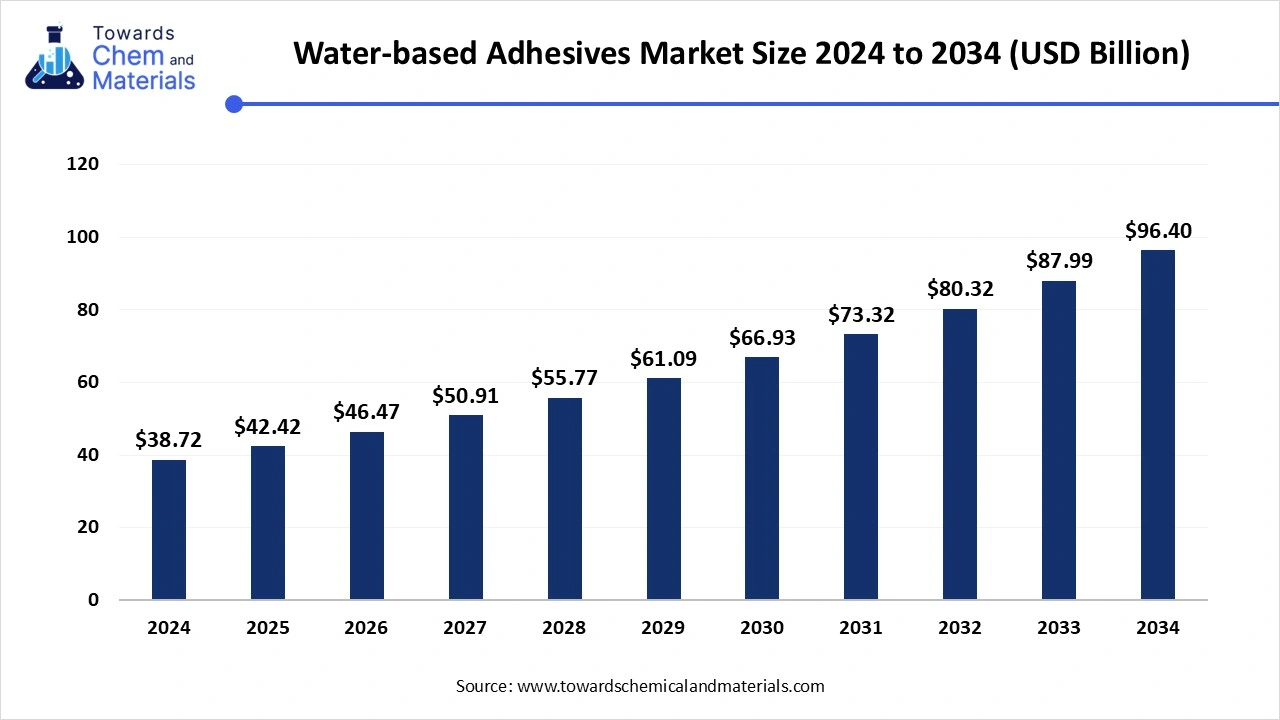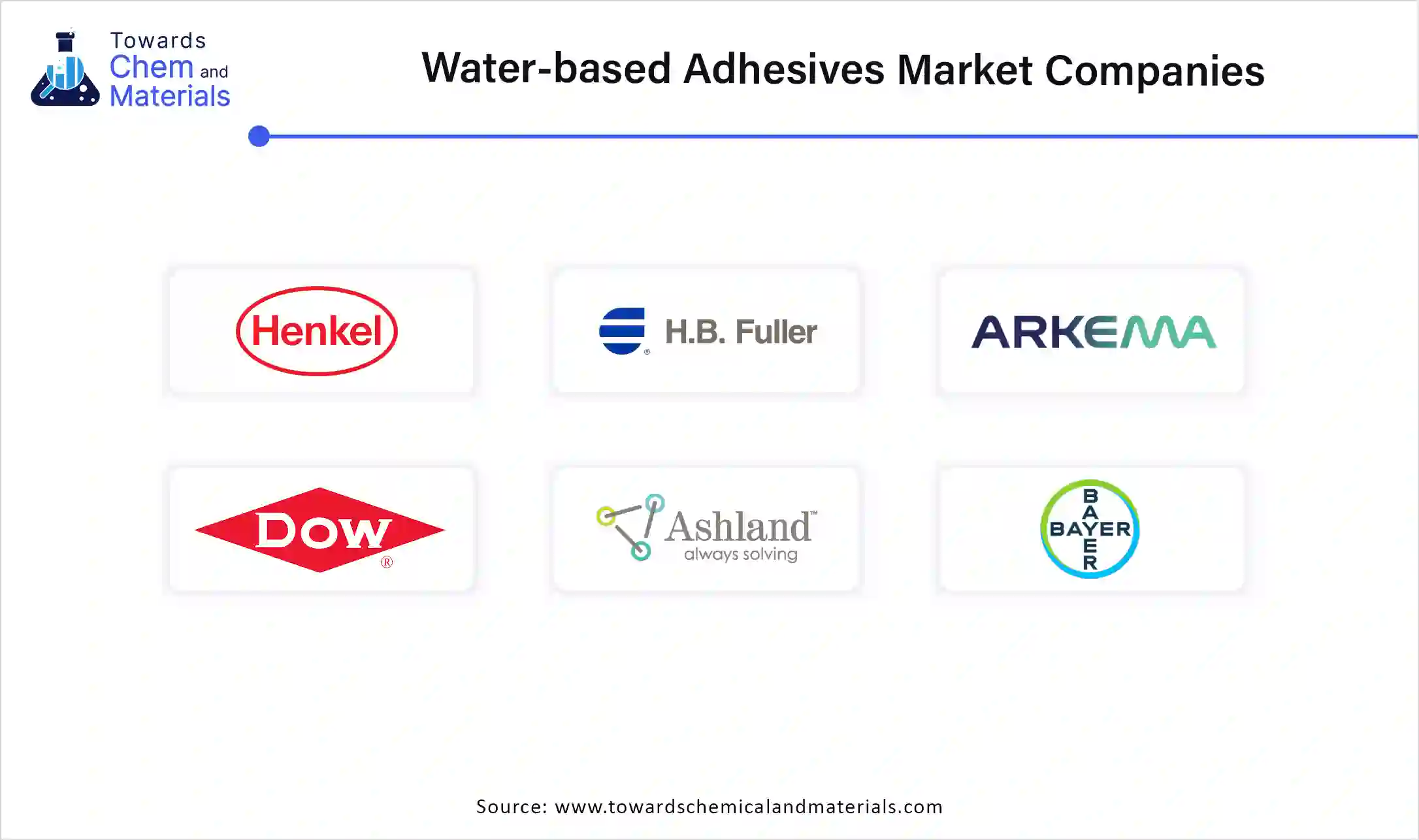December 2025
The global water-based adhesives market size was valued at USD 38.72 billion in 2024 and is estimated to hit around USD 96.40 billion by 2034, growing at a compound annual growth rate (CAGR) of 9.55% during the forecast period 2025 to 2034.The rapid industrialization and shift towards environmentally friendly products due to growing environmental concerns have helped this market to grow.

Water-based adhesives are bonding materials developed by using a combination of water, polymer, and additives. Water-based adhesives form a bond between the two substrates once the water within the formulation is evaporated or absorbed by the substrate. They are popularly used for bonding porous substrates. They can be natural-based or synthetic-based materials. They are the nontoxic, eco-friendly, and low voc adhesive compounds used in industries, residential, or commercial spaces.These resins use water as a solvent, which reduces the risk of toxicity and makes them harmless. The water adhesives are used in every industry as adhesives.
The increasing demand for water-based adhesives has driven this market to grow, and the shift towards environmentally friendly product use has increased the demand for water-based adhesives in the packaging, automotive, and construction industries. The increasing demand for green buildings and stringent environmental regulations are shifting industries to replace solvent-based adhesives with water-based adhesives. Government policies in the manufacturing of sustainable and eco-friendly products have increased the production of these adhesives. The growth in various industries ultimately increases the demand and helps in the expansion of the water-based adhesives market.
| Report Metric | Details |
| Market size in 2025 | USD 42.42 billion |
| Expected market size in 2034 | USD 96.40 billion |
| Growth rate | CAGR of 9.55% from 2025 to 2034 |
| Base year for estimation | 2024 |
| Forecast period | 2025-2034 |
| Dominant region | Asia Pacific |
| Segment covered | Resin,application,region |
| Key companies profiled | U.S.; Canada; Mexico; Germany; UK; France; Italy; Spain; China; India; Japan; South Korea; Brazil; Argentina; Saudi Arabia; South Africa |
The adhesive companies are developing new and innovative advances in the formulation of water-based adhesives with enhanced adhesion strength, water resistance, and faster curing methods. Bio-based adhesives from renewable sources are gaining the interest of consumers. The introduction of nanotechnology in the formulation of the enhanced water-based adhesive, like the integration of nanoparticles, improves adhesion, durability, and moisture resistance properties of the formulation. A combination of acrylic, polyurethane, and epoxy formulation results in multifunctional adhesive, these adhesives provide high strength, chemical resistance, and fast curing time compared to traditional formulations. For automotives, self-healing and self-cleaning adhesives are being formulated, which drives the market to grow at a rapid rate due to an increase in demand.
The cost of raw materials is high, which is a limiting in the growth of the water-based adhesive market. Dependency on petrochemical derivatives hinders growth as the crude oil prices are very high, and disruption in the supply chain of the raw material impacts the price of the final products. The increasing demand for sustainable materials demands biobased adhesives, and the cost of biobased adhesives is higher than that of traditional adhesives, which limits the production capacity because of high raw material costs. Supply chain disruption because of geopolitical tension, shipping constraints affect raw material availability which affects the cost of the raw material and the final cost of the product.
Asia Pacific dominated the water-based adhesives market in 2024. This is because it is the fastest-growing region due to industrialization, urbanization, infrastructure development, and new innovations in formulation and performance of adhesives. The increasing e-commerce, food packaging, and consumer goods drive the market to grow in the Asia Pacific region.
India and China lead in the building and infrastructure projects, due to their growing economy and developing government-led infrastructure projects, which is because of the massive growth in the construction industry. Automotive sector expansion in Japan and South Korea, since they are the hubs for vehicle production. Government initiatives and policies for eco-friendly components drive this market to grow in the region.
North American expects a significant growth in the market during the forecast period. The growing e-commerce and the use of environmentally sustainable adhesives in the industries drive the market to grow in the region, advancement in the technology of water based adhesive formulation has help in expansion of the market and increasing adoption and demand for green and eco-friendly building has shaped the growth of the market in the North American region. Strict regulations for sustainable and eco-friendly product use in the region contributed in the growth of the market.
In the U.S. and Canada, the increasing demand for water-based adhesives is from the packaging industry due to the increase in e-commerce, and the California Air Resources Board promotes the shift to water-based adhesives. Lightweight vehicle requires advanced adhesives and an increase in the automotive industry in the region demands water-based adhesives.
The acrylic polymer segment dominated the water-based adhesives market in 2024. These are most widely used due to high adhesion strength, UV resistance, and flexibility of the material. They are commonly used in pressure-sensitive adhesives, the packaging and construction industry. The rising environmental concern and
The polyvinyl acetate segment is anticipated to grow significantly in the water-based adhesives market during the forecasted period. Widely used in woodworking, furniture, and bookbinding due to strong adhesion to porous surfaces. They are the most cost-effective and easiest to apply adhesives. Versatility and strong bonding of the polyvinyl acetate make them hold a significant share in the market of adhesives.
The tapes and labels segment dominated the water-based adhesives market in 2024. The tapes and labels are used in demand as they are used for product tracking, barcodes, security seals, and for instruction labels. The need for durable and moisture-resistant tapes and labels drives the market to grow as they are widely used by the packaging industry.
The woodworking segment expects a significant growth in the water-based adhesives market during the forecast period. The growing furniture industry, due to an increase in construction and infrastructure development in the regions, has increased the demand for strong bonding, easy-to-use adhesives, which are essential for furniture manufacturing, cabinetry, flooring, and panel bonding.

December 2025
December 2025
December 2025
November 2025